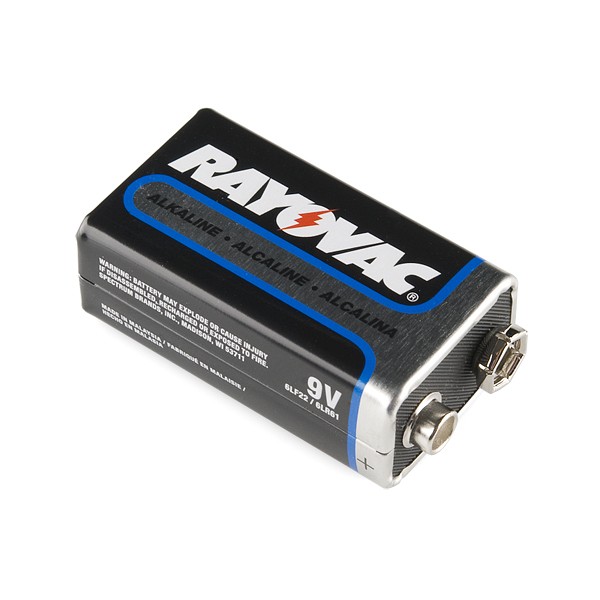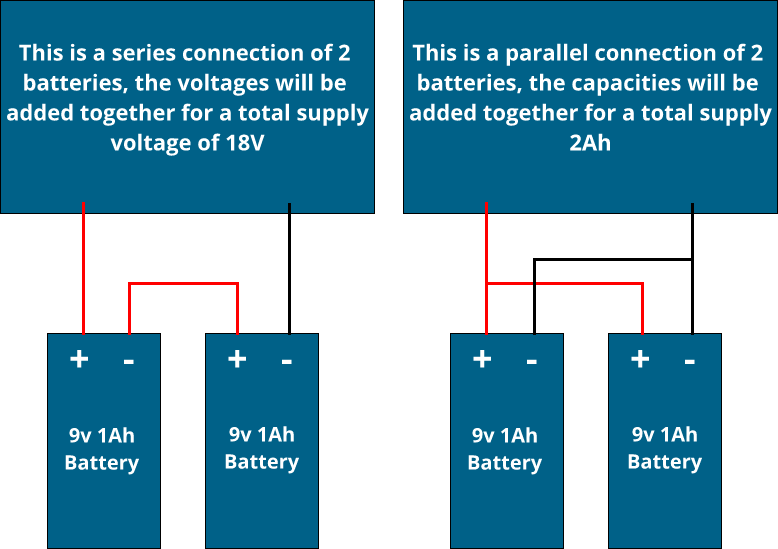
Batteries sport a nominal voltage rating alongside their charge (capacity). Their voltage is entirely dependent on their internal chemistry too, and it's called a 'nominal' voltage because when the cell is 100% charged, its voltage will measure a little different to when depleted. Capacity is an expression of how much power the battery can store and is usually given as Amp-Hours. That is how many hours the battery can supply a certain charge for. In theory, this means that we can draw 3 Amps of power from the battery for 1 hour to deplete it; however, the batteries chemistry dictates the typical usage of the battery.
 Batteries in series and parallel
Batteries in series and parallel
It's not very often we find a battery capable of providing the perfect voltage/current for our projects. There are two main concerns we see surrounding these two specifications too; the battery's voltage output is incompatible with the circuit, or the charge of the battery is not enough. If we are only connecting one battery to our circuit, we are limited to the specifications of that battery. However, if we match cells via their mAh and voltages, it will allow us to connect them in series (if we wanted to add their voltages) or parallel (to add their charge capacities).
That's right; we can take three 1.5V AA Alkaline Batteries, hook their positive terminals to their negative terminals and turn them into a combined 4.5V power source. Or we could connect three Lithium 9V batteries in parallel for a whopping 3600mAh of 9V power. Of course, there are a few rules and limitations that we inherit with batteries; made relevant as we are using chemical cells as building blocks for portable power supplies. Rule number 1 is; don't mix and match batteries that have different voltages. It's a sure-fire way to deplete your batteries at uneven rates.
Microcontrollers such as the Arduino have in-built voltage regulators to help with normalizing voltages down to a stable voltage for the chip to work with. Check your circuits datasheet to ensure you are using the correct voltage input for your device.
Disposable Battery Types
When it comes to disposable batteries you have two types that you see:
- Alkaline: These are the typical batteries you would pick up at a convenience store that you use until they die; then throw them away. We won't get into the chemistry behind how they function but expect to see a longer shelf life than their rechargeable counterparts (up to 7 years in most cases). Their voltage will also decrease quite slowly if they are used in regular, "normal-drain" applications, and once their voltage becomes too low to power your circuit you simply replace (or repurpose) them. Alkalines are terrible for high-drain applications; as the internal chemistry limits how much power can be generated over a period. An alkaline cell with have a decent capacity (mAh), but you rarely see it displayed on the packaging of the battery as it's typically the same across for different form factors of the battery. These batteries are also the most prone to leakage, so if you are building a self-contained circuit they might not be the right choice for you.
- Lithium: Don't mistake these batteries for Lithium Ion batteries or their LiPO brothers, these are disposable lithium cells that are surprisingly good in high-drain applications. The big downside to these batteries is they are quite pricey; there's a small possibility of the battery exploding (very small, but it's still there) and they are extremely difficult to safely dispose of once depleted. Expect to see the voltage of Lithium cells drop quite suddenly once the battery comes to the end of its life, their shelf life is around 15 years, though.
Rechargeable Battery Types
Depending on your project's requirements; you'll quickly discover if your battery has to be rechargeable or disposable. You'll ask yourself "Do I want the cost of my batteries to be a recurring cost, or do I want it to be a one-time cost". The reusability of a battery comes down to the chemical composition of it. Alkaline batteries seem to be the go-to single-use option, seen as inexpensive comparatively, but they simply aren't if you take into account that you'll be replacing them a whole bunch. The typical batteries we see in rechargeable applications are:
- Nickel Cadmium (NiCd) Batteries were a real mess of a rechargeable battery option; you might have heard of them. They were the ones that had specific memories that would crop the battery life every time you didn't discharge it all the way. They are now moving out of the market entirely, replaced by their NiMH counterparts.
- Nickel Metal Hydride (NiMH) are one of the most common battery types we see in high drain applications. Pololu has a great range of different sized NiMH Rechargeable batteries available too, with packages ranging from AA and AAA in-series options for motors circuitry, etc. These batteries are a non-toxic, large capacity battery that's perfect for most applications. The biggest downside to these batteries is their self-discharge rate; we typically see these batteries lose 20% of their capacity after just a month of being idle, up to 100% after a year. The voltage drop we tend to see with these batteries is almost instant, dropping from a healthy voltage to 0V suddenly. There is a recommended charge cycle limit of around 1000 charges with NiMH batteries; you can get chargers that can tell how safe your battery is to use too.
- Lithium Ion (Li-Ion) - These are very powerful rechargeable cells, with their AA/AAA sizes being rated for a nominal voltage of around 3.7V. This means if you get a Li-Ion battery mistaken with an Alkaline counterpart you might damage your device instead of powering it. Another great option for high-drain purposes. Beware, though; these batteries will require a special charger.
- Lithium-Polymer (LiPO) - These batteries are quickly becoming everyone's favorite rechargeable battery, but they aren't perfect. We've written a guide specifically for safely using and charging LiPO batteries, it also includes information about wiring them and how to avoid dangerous situations when using them. Check it out here.
The general applications of these rechargeable batteries are the same as any disposable battery, but there are a few differences we should be aware of especially when dealing with LIPOs; we will cover that more thoroughly in the Using LiPO Batteries tutorial, though!
We have a bunch of options for connecting regular disposable batteries in series and parallel, they will help you to power your circuit with the right voltage. Check out the range here if you are looking for a multitude of different battery holders for your projects!

 Batteries in series and parallel
Batteries in series and parallel
